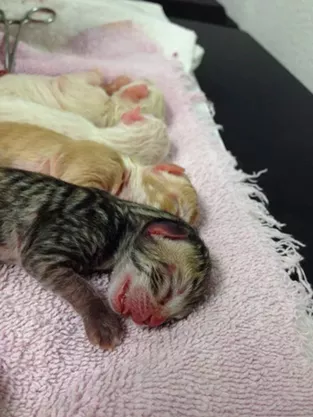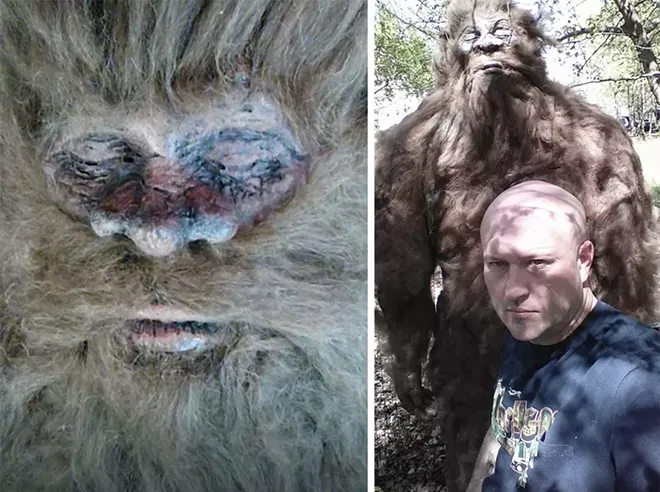Monday, March 31, 2014
Earlier this year, a Las Vegas man named Rick Dyer released startling proof of Bigfoot: a photo of weathered corpse he dubbed “Hank” after reportedly luring the creature with barbecued ribs and shooting it outside his tent near San Antonio in September 2012.
Dyer hit the road for a national tour with the body, saying it was “100 percent real” and being DNA-tested at a university he wouldn’t name until the results came back.
Given that it’s Bigfoot and Dyer has a history of fakery, rumors were swirling almost immediately about where the body actually came from and who could have created such a thing. Commenters on Bigfoot forums mentioned the possibility that it originated in Spokane.
Now, after a spiteful falling-out with his crew, Dyer has admitted it’s a fake. And it was in fact made right here in Spokane.
From Dyer’s “Official Statement” on Facebook:
From this moment own I will speak the truth! No more lies, tall tales or wild goose chases to mess with the haters! No more longing into my hater acct to heat the pot. All the so called info the haters received came from either me or a team members that I directed . True or not we just wanted people to talk eg.Prop maker, Addresses, People involved. It was crazy just for the attention!
The people on my tour knew everything from day one, They just didn't expect me to ever come clean, They thought they could say anything they wanted and I couldn't respond without giving my self up!..
He’s since said that although this was a fake, he does indeed have a real Bigfoot body that he hasn’t displayed for fear it will get stolen.
Anyway, the verifiable truth about the Bigfoot’s origins soon came out: It was crafted by Chris Russell, who makes detailed masks, props and costumes here in Spokane with his company, Twisted Toy Box. He says it took about two weeks to make the creature out of latex, foam and camel hair and was told it would be used as a movie prop.
Russell said he’ll do only one interview on the topic, and did that this weekend with Laura Michaels, who posted the full exchange on Facebook along with Russell’s request that it be shared and presented in full without any edits. So, here it is:
Laura Michaels: When did Dyer first contact you? And, what did he say? Also, did you know who he was right away when he called you? Did his name sound familiar?
Chris Russell: He contacted me last year inquiring about having a prop bigfoot body made. I did not know him or his name prior to the phone call. He asked about different styles of props and I discussed options and prices for his body from realistic silicone and punched hair to the flat back prop with glued hair that was chosen.
LM: You said he wanted the body made to use to tour the country while filming a movie for a film studio. When did you find out that he was traveling around with Hank and charging people to see a "real" Dead Bigfoot?
CR: Within a couple of days of Rick picking up the body I began hearing internet buzz and news reports on Rick and his story.
LM: Besides saying he wanted to to look like an old, poorly made, taxidermy prop, did he have a specific idea of what Hank was to look like? Facial features, skin abrasions, etc..? On one Facebook page, called "Bigfoot", the admins went to Vegas to see, study, and take several pics of Hank. This is just a little text of what they said about the body: ~~~ The specimen has moles, blemishes, hair patterns, open sores, veins just below the skin, fingerprints, injuries to the hands, fingers and toes, and what looks like scars on the forehead from likely impact with branches and trees.~~~
Did you specifically do that, because from the pictures they took, it DOES look like there's moles and such, or is it just in the making of the body, the materials used make it look that way?CR: Rick did send me drawings and images of bigfoot and asked me to recreate certain features in his prop like facial features, fur, feet etc.
Many of the features explained in your question were intended by myself, although some were just happy accidents due to the nature of casting latex and foam.LM: How long did it take to make Hank, start to finish? Also, was Rick trying to rush you to get it done ASAP?
CR: When Rick inquired about the prop he did ask if I could have it finished in December 2013. I accepted the job knowing I was booked on current projects that would be finished to allow time for Ricks project. I was paid and put the job on the project board in the shop. Once I started the project it was sculpted, molded , cast, painted and haired within two weeks. Rick did not rush me, I agreed to finish the job by a certain time and I did.
LM: When Rick showed up to your shop, who was with him? Who helped him load the body into the trailer? You said there was one person. Do you know if him name was Lynk? He's ethnic, from Trinidad and Tobago...that's the story we've gotten.
CR: Rick did have one person with him who came into my studio and did see the propknowing it was fake. I asked Rick to only bring one person into my studio with him and I was introduced to the person although at this point I do not remember his name but I believe that person to be Lynk according to his description. Rick and his associate came into the basement of my studio and I lifted the body made of latex and poly foam by myself and took it upstairs where Rick and his associate put it into the box added curtains around the edge of the box and the three of us pushed the box down the driveway into the back of his "Rick Dyer see bigfoot inside " trailer that was parked in front of my studio.
LM: What can you tell us about "Project Footprint"? I know that was the code word, but you also told me a little about it last night. Can you explain a bit about it? Is this the movie that Dyer claimed to have been/still is filming for a studio?
CR: Project footprint is the code word that Rick Dyer and myself used to communicate about the project. There was an agreement because of the top secret nature of the prop that we neither of us would speak to anyone about this unless the code word project footprint was spoken.unless this was said I was to keep everyrhing a secret and never admit involvement. My phone had a phone number listed under project footprint that Rick would call me from and I also received emails with the code word project footprint and information about the project. Rick had initially said that we needed a code word to know if it was okay to talk about this and project footprint was my suggestion.
LM: Although Rick has confessed to having the body made, he still claims he has at least one Bigfoot body...somewhere.
Did he ever tell you, during any of your conversations, that he DID kill a Bigfoot?CR: Rick has maintained throughout all of our correspondence that he did indeed kill a real Bigfoot yet needed a prop body to take on tour so that the real Bigfoot would not be stolen.
Tags: Culture , Bigfoot , hoax , Arts & Culture , Image
When exactly does the enrollment period end?
You must finish your application and make your first payment online by 11:59 pm tonight. Your coverage will start on May 1. Otherwise — unless you have a "qualifying event" or experience technical issues beyond your control (see below) — you'll have to wait until the next enrollment period, Nov. 15, 2014 to Feb. 15, 2015, for health coverage in 2015.
I've been trying to finish my online application all day, but argh@#$%& so many errors!
If technical problems on Washington Healthplanfinder are keeping you from completing the enrollment process, you still may be able to buy health insurance later and avoid a penalty for being uninsured. But this only works if you've made a "good faith effort to get health insurance," says Michael Marchand, communications director at the Washington Health Benefit Exchange.
If this happens to you, call 1-855-923-4633 or email customersupport@wahbexchange.org with as much information about your application as you can provide and the errors you encountered.
"We'll be looking at those cases and evaluating them individually and making the determination whether they can get additional time to complete it," Marchand says. "We have the ability to trace every application in our system, so we know when people have started. We know the last time the application was worked on in the system. We also know the last time a person has called our toll-free line.”
That said, customers starting the enrollment process at 11:58 pm tonight probably won't get a deadline extension and neither will those who incorrectly or incompletely fill out their applications.
I recently experienced a major life change. Do I get an enrollment extension?
Having a baby, adopting a child, getting married or divorced, losing a job or getting a new one — these are what the health exchange calls "qualifying events." And yes, if a major life change happens to you, you would be eligible for a 60-day "special enrollment period" after tonight's deadline. You'll still get health coverage this year and you won't have to pay a penalty. On the Washington Healthplanfinder website, there's a "special condition" questionnaire in which you can report your qualifying event. You'll later receive an email directing you to submit appropriate paperwork — a copy of your marriage license, child's birth certificate, layoff notice, etcetera — to the exchange.
So what's the "penalty"?
The penalty for being uninsured is $95 per adult and and $47.50 per child, or 1 percent of your household's annual income — whichever is higher. You'll pay this fee on next year's federal tax return. (Some people, such as Native Americans, are exempt.)
Still, I don't think I can afford insurance.
If your annual income is 138 percent of the federal poverty line or below, you'll qualify for Medicaid in Washington, which you can sign up for anytime. If not, there's a good chance you're eligible for tax credits to offset the cost of your premiums. In Washington, 81 percent of enrollees have qualified for financial assistance. This handy chart from Healthcare.gov shows whether or not you can save money on your health insurance:
Can anyone help me sign up for health insurance?
Get in touch with an in-person assister at these local nonprofits and hospitals to guide you through the process or call the exchange's toll-free customer support line at 1-855-923-4633. If you call the customer support center, chances are you'll experience long wait times. But as long as your call is in queue by 8 pm, Marchand says a representative will speak with you.
Tags: obamacare , affordable care act , health reform , News , Image
And he's no stranger to the Pac-12. Ernie Kent, who coached at the University of Oregon from 1997 to 2010, during which he took the Ducks to two Elite Eights, was named the new head coach this afternoon.
“I am excited that Ernie will be the leader of our men’s basketball program. I have witnessed firsthand his many talents. He has proven that he can win championships in our conference. Together we saw tremendous success at his alma mater and I have every reason to expect to see the same at mine," said WSU Athletic Director Bill Moos in a statement.
Kent will be formally introduced in Pullman on Wednesday.
The hire comes just a few days after WSU's efforts to woo Boise State head coach (and former Gonzaga assistant) Leon Rice fell flat and Rice decided to stay at BSU, receiving a nice raise in the process.
Before coaching at Oregon, Kent — who played at Oregon, too — had a successful run at Saint Mary's. His all-time head coaching record is 235-174.
Since being let go by Oregon four years ago, Kent has been a commentator for the Pac-12 network.
Jury selection began today in the controversial manslaughter trial of Spokane plumber Gail Gerlach, who shot and killed a 25-year-old man in March of 2013 as the man drove away in Gerlach's stolen SUV. Prosecutors considered the shooting a case of excessive vigilantism while Gerlach's supporters argue a right to defend his life and property.
We wrote last year about the legal gray areas in Washington state's self-defense law. Subjects must demonstrate they felt themselves or others were in immediate danger of significant physical harm, a perception somewhat in the eye of the beholder.
Investigators say Gerlach left his SUV idling in his driveway along Lee Street shortly before 8 am on March 25, 2013. When he emerged from his home, he saw the vehicle backing out and then speeding away down the street. Gerlach acknowledges he drew his pistol from his holster and fired a single shot through the back window.
Court records state the bullet went through the window, through the driver's seat and struck Brendon Kaluza-Graham in the back of the head, killing him instantly.
Gerlach tells investigators he saw the driver turn in his seat and raise his hand with what he thought was a gun. Fearing for his life, Gerlach says he fired on the driver.
Investigators found no gun or other weapon on Kaluza-Graham. They also noted the dark-tinted windows and driver's seat head rest would have likely obscured Gerlach's view. When officers arrived on scene, Gerlach reportedly fretted over his decision to fire on the vehicle.
"Gerlach told [an officer] that he had been scared and that he did not know whether he had done the right thing," court records state. "He wondered aloud whether he should have simply gone back inside the house rather than shoot after the car. Gerlach repeated several times that he hoped the driver was not hurt."
Defense attorneys say Kaluza-Graham had vehicle theft tools and drugs on him. He also tested positive for methamphetamine. They argue Gerlach felt a legitimate threat to his and his family's safety.
Court records indicate the trial will likely stretch into late next week. Gerlach could face up to 10 years in jail if convicted of first-degree manslaughter.
Tags: Gail Gerlach , Brendon Kaluza-Graham , self-defense , News , Image
Today, Mayor David Condon officially used his veto power for the first time in his term, to overturn a recent ordinance intended to close what a majority of Spokane City Council members saw as a major loophole in the state’s growth management policies.
(Explaining the loophole takes a little bit of work, we took a crack at it here. Suffice it to say, it’s allowed dense development to slip into areas where dense development is currently forbidden.)
Basically, the vetoed ordinance prevented the city from committing to extend certain water and sewer services to properties in expanded Urban Growth Area boundaries before the legal challenges to the expansion had been resolved.
But developer groups, and major supporters of Condon, objected intensely to the change: They argued that it could run afoul of state law and expose the city to costly legal action (Center for Justice sent out an email Sunday strongly disagreeing with this argument), that it didn’t follow the proper process through the council, and that it could seriously delay or prevent new development in the county. (Councilman Jon Snyder, the sponsor of the ordinance, estimates the maximum delay would be about a year.)
In vetoing the bill, Condon critiqued the process through which the ordinance was brought forward and passed, and cited “uncertainty” as the primary reason for his veto.
“It is legal uncertainty. It is uncertainty from those who do economic development, it’s uncertainty, quite frankly, as I talk to those who are concerned about the environment, saying, what does this exactly do, Mayor?” Condon said. “I don’t know whether this legislation, for those who are involved in the environmental side, does really what we want to do anyway.”
He also announced an agreement with Spokane County to put any city annexations or additional county urban growth area amendments on hold for a year, while the commissioners and city work on agreements for future growth planning and revenue sharing.
“With this veto, I’m also calling on our county commissioners to bring new jobs and opportunity to Spokane’s region, while maintaining our quality of life,” Condon said.
At 1 pm today, several council members held a press conference to object to the veto. In a press release, Snyder says, “The commissioners have essentially created a shadow city of urban growth around the city of Spokane. Each time they expand the UGA it acts as stealth tax increase for our citizens. With his veto, is the mayor representing the county commissioners' interests or the interests of the citizens of Spokane?”
Merits of the veto aside, historically, this is a huge deal: Spokane mayors have had veto-power for less than 15 years, and in that time they’ve only used the power a handful of times.
Until this year, Condon has had a more friendly council. But with a shift of one vote in the balance of power, and Council President Ben Stuckart willing to strike a hard line over committee assignments and undo the decisions the previous council has made, the prospect of many more mayoral vetoes are a possibility.
And when they’ve vetoed, it usually hasn’t even made a difference. All it takes is five council votes to override a mayoral veto, so vetoes have sometimes been more of a political statement than anything that has made a difference.
Here’s a quick rundown of major mayoral vetoes — or almost vetoes — in the past:
1999: In a vote with a razor-tight margin in the previous November’s election, Spokane moves to a “strong mayor” system, which gives mayors the power to veto city council legislation.
2001: For the the first veto of his term, Mayor John Powers vetoes a collection of amendments to the city's comprehensive plan.
Later that year, he nixes a council plan to loan $800,000 to help the troubled River Park Square parking garage. But an Inlander story noted that he seemed hesitant to use his veto powers: “His supporters maintain that Powers' reluctance to assert his veto-power isn't necessarily a sign of weakness.”
2002: Powers partially vetoes the city budget, and later vetoes a proposed property tax increase. The city council does not overturn either veto. In 2003 he proudly cites the property tax veto as a reason to reelect him. He is not reelected.
2004: Mayor Jim West vetoes a city ordinance to require bicyclists to wear helmets, but the city council, including French, and future mayors Mary Verner and Dennis Hession vote to override it.
2005: Mayor Jim West threatens to veto an ordinance that would grant city benefits to domestic partners. But after a sex scandal surrounding West is published in the Spokesman-Review, and the council gets enough votes to override the veto, West decides not to.
2008: Mayor Mary Verner considers vetoing an ordinance allowing big-box stores in the Southgate residential neighborhood, in particular because of a change by the city council to allow even larger stores than originally intended. The change angered many, including Jon Snyder, who said “the neighborhood was promised a full planning process and what they got was a couple-day charette and then they got the rug pulled out from under them.”
“It is my strong desire to veto [a] portion of the ordinance,” Verner wrote, according to an Inlander story.
Instead, she chose a more mild form of protest: refusing to sign the ordinance.
2009: Mary Verner exercises her first mayoral veto, attempting to strike down new shoreline development restrictions next to Latah Creek. But the City Council came together to push it past the veto. It takes four votes to pass something on the council. It only takes five to override a veto.
(Al French, now a current county commissioner highly critical of the city’s UGA decision, was one of two council votes to supporting a veto.)
2011: Condon hits Verner for not vetoing the water rate increase back in 2011. He used it as ammunition in a debate.
"Well then I would ask the mayor, why did she not veto [the water rates]. She had two opportunities to veto it, she could have vetoed the structure last year, and she could have vetoed the 16 percent increase across all that structure just a couple weeks ago," Condon told Verner in September 2011.
After losing the election, Verner vetoes one specific comprehensive plan zoning change up on the South Hill, but the council overrides her.
2014: Condon chooses to veto the UGA ordinance.
“[The veto measure is] one that I’ve contemplated in past actions,” Condon says, “There’s another way that mayors don’t have to do anything, and that is just to allow them to come effect. I have not done that…. You want to look at, where we are at with the process, how are we getting there.”
In many of the cases, he says, there have been bills he didn’t personally agree with, but the council and the administration have been able to negotiate over those concerns.
Tags: veto , mayor , Spokane City Council , David Condon , News , Politics , Image , Video
In my column in the print edition of the Inlander this week, I wrote about the Idaho Legislature’s unanimous decision to begin a $33 million, 5-year investment to reduce recidivism and save the state an estimated $288 million in prison costs. It’s a decision that’s good for Idahoans’ pocketbooks and our collective conscience. (The savings are found in part by ensuring penalties more closely match the crime committed.)
The investment was spurred by a fantastic study by the Pew Charitable Trusts and the Council of State Governments. A new report suggests another step towards justice and away from expensive vengeance would be to eliminate Idaho’s death penalty.
Earlier this month, Idaho’s nonpartisan Office of Performance Evaluations released their findings that sentencing a defendant to life in prison without parole is less expensive than imposing the death penalty.
They were unable to find out exactly how much is saved because of a failure to track all the associated costs of carrying out capital punishment in Idaho. However, they report, the longer appeals process for death sentence cases makes it clear that Idaho would realize significant savings by ending the practice.
It’s a curious study and a part of me isn’t sure that it’s a good idea to be calculating the cost to society of legally killing people in dollars and cents. Still, it does raise a question: How much is vengeance worth? Specifically, how much more should we be willing to spend to try to execute someone rather than send him to prison forever?
I write “try to execute someone” because, for the most part, Idaho has been unable to carry out the vengeance it seeks.
More than $4.6 million has been spent in Idaho on capital defense costs since 1998. Presumably a similarly large sum has been spent on their prosecution. During that time, the death penalty was sought 42 times and imposed in only seven cases — and of course some of those cases are still up for appeal.
Since 1977, when the U.S. Supreme Court reinstated the death penalty, 40 people have been sentenced to death in Idaho. According to the Associated Press, of those “21 have had their sentences overturned on appeal or are no longer sentenced to death for other reasons, 12 are still appealing their cases and four died in prison. Just three were executed during that time span.”
Even if vengeance is desirable, that seems like a pretty bad return on investment. In most cases, we are likely spending hundreds of thousands of dollars to achieve exactly the same result as we would have by asking for a life sentence originally.
Is it worth it? If you still say yes, at what price wouldn’t it be? How much should we be willing to raise taxes so that instead of locking up 40 people for life, we lock up 37 and kill three? How many teachers should we be willing to lay off? How many roads should go unplowed? How much is vengeance worth? ♦
John T. Reuter, a former Sandpoint City Councilman, is the executive director of Conservation Voters for Idaho. He has been active in protecting Idaho's environment, expanding LGBT rights and the Idaho Republican Party.
Tags: death penalty , Comment , commentators , Image
HERE
A police standoff Sunday morning on the South Hill ended with 25-year-old Timothy Jacobs fleeing the scene. He allegedly stabbed and punched his girlfriend and is still on the loose. (KXLY)
After 44 years, a Coeur d’Alene Vietnam veteran finally receives war medals. (CdAP)
The recent Pacific Northwest Qualifier for middle school and high school volleyball teams brought in $4.4 million to Spokane’s economy, according to Visit Spokane. (KHQ)
THERE
The heartbreaking Snohomish County mudslide has reached a death toll of 21, with 30 people still missing — down from the previous 90. (ST)
A United Nations climate change panel released a report today that says the worst is yet to come. (NYT)
North Korea fires, South Korea responds. (CNN)
SPORTS
Mariners play tonight at the Los Angeles Angeles home opener. Obviously, the Mariners will win, Felix Hernandez is pitching. (MLB)
Yes, March Madness NCAA basketball tournament is still happening. After a crazy weekend, the Final Four teams are Florida, UConn, Wisconsin and Kentucky. (B/R) Hopefully, for all of the money you most likely bet, your bracket reflects this.
Tags: Morning Briefing , News , Image
Sunday, March 30, 2014
This week's cover story was born of a tragedy you've probably heard about by now. Last month, a 55-year-old homeless man named Don Foster was hit by an SUV on Mission Avenue. The driver of the SUV left. Then, at least two more vehicles hit Foster and also left. By the time police arrived, the scene was gruesome and the unanswered questions were many.
You and I probably had the same reaction: How could someone do that? How could you leave a man to die? When this story made the rounds in local media, the comments sections were full of the same sentiment. Everyone, it seemed, had an opinion about what they would or have done and what sort of justice they thought the drivers who hit Foster deserved.
Even the officers investigating the case were left wondering.
"Multiple people [were] involved in it and didn't take the responsibility," Officer Paul Taylor told me. "I don't think frustrating would be a strong enough word to describe how somebody could do that to another human being."
(Police are still investigating the case and say it's a top priority. If you have information, call Crime Check at 456-2233.)
The Spokesman's Sean Vestal wrote a moving column — "As man dies in roadway, no one stops" — about the victim, urging that his anonymous death not be all we knew about Don Foster.
The whole event, and others like it across the country, sticks with us for the big questions it asks, and those are the questions I attempt to take on in this week's story. What causes us to help each other sometimes and leave each other helpless other times? Are we hardwired to be kind, or are we in a battle against our deepest tendencies toward selfishness?
The answers are complex and we're often not very good at predicting what we would or wouldn't do in any given situation. In one study, David Lishner, a professor and researcher at the University of Wisconsin-Oshkosh, described someone in need to a group of research participants. When asked whether, if there was some opportunity to help, about 80 percent of participants said they would. When another group was given an actual, concrete opportunity to help in the same situation, just 30 percent volunteered.
We're certainly not the first to ask these questions. In fact, science has been wrestling with this for a long time. If you're interested, check out Radiolab's "The Good Show," Richard Dawkin's theory of "The Selfish Gene," any of the many meditations on Kitty Genovese's death, this exploration of whether we can build a more empathic civilization or this heartbreaking Washington Post story about a woman hit by multiple drivers on the Beltway near Washington, D.C., which also explored these questions.
In reporting on the psychology and biology behind helping behavior, I found a fascinating range of stories and science on the issue. I hope they'll get you thinking too. But in the end, an equally big question remains: If we can understand empathy/compassion/kindness, can we encourage it?
Emma Seppälä from Stanford's Center for Compassion and Altruism Research and Education believes we can. By setting an example for others, she says we can make compassion contagious. Here in Spokane, start by exploring local volunteering opportunities or learning CPR and signing up for the Spokane Fire Department's PulsePoint app to be notified when someone nearby is experiencing cardiac arrest. Pick up litter, talk to a stranger. The bottom line: Kindness is not out of your reach.
Read "What Would You Do?" here. Send feedback to editor@inlander.com or reach me at heidig@inlander.com.
Saturday, March 29, 2014
I love being able to step back and say, “Wow Spokane!” The city I grew up in is amazing, and I am so glad my wife and I chose to settle here for the rest of our lives. This past weekend was another one of those “wow” moments. WSU, a great community partner, hosted the 2nd and 3rd rounds of the NCAA Men’s Basketball Tournament at the Spokane Arena on Thursday and Saturday. More than 33,000 passed through our arena’s turnstiles to watch the country’s best student-athletes from eight universities. The Spokane Convention Center also hosted the PNQ Volleyball Tournament with an attendance of well over 15,000. These events took place in Spokane because of investments we have made in our quality of life and facilities over the past 20 years.
It wasn’t the sheer number of attendees this weekend that ‘wowed’ me. It was the special interactions I witnessed our visitors having with our city. “This river is so amazing.” “Look at this view, you’re so lucky to live here.” I heard so many positive comments as my friends from out of town and I strolled through Riverfront Park and over the suspended bridges to the arena. They’re right. I’m lucky I live in a place with a gem like Riverfront Park. That’s why I pledge my full support to the implementation of the Riverfront Park Master Plan so that like our newly renovated arena, we can continue to attract even more admirers to the centerpiece of our city.
Speaking of the arena, I have been to more than 30 of them in the past 10 years, and I have never seen one as clean and efficiently run as the Spokane Veterans Memorial Arena. And I’m not the only one. NCAA officials commented this week that they have never seen a cleaner facility. Not only has the Public Facilities District bond assured us of our ability to attract these types of major events, but the use of local contractors and labor in these projects has kept many of our neighbors in jobs during this economic downtown.
This past weekend was a reminder that we live in a cool city. From the high school volleyball team singing the theme song to Frozen on the bar top at O’Doherty’s (been there, done that) to the full Davenport Hotel, fans from San Diego, Michigan, North Dakota, Boston and Seattle caught a glimpse of the place we are lucky to call home. Our investments are paying off. Yet there is even more we can do. Each time we invest in our public facilities, parks, and airport we also invest in our local businesses like hotels, bars, and restaurants. Each time we support school levies and donate few bucks on Crowdswell for small neighborhood projects, we invest in ideas and community. It’s an exciting time to live in Spokane. I can’t wait for the next big event to “wow” me.
Ben Stuckart is the president of the Spokane City Council.
Tags: Comment , Spokane Arena , Riverfront Park , Image
Friday, March 28, 2014

Kittens are definitely all sorts of ridiculous cute, but even so, no one should be letting their un-spayed female kitty intentionally (or ignorantly) breed. Pet overpopulation is not a good thing. Still, it continues to be a national and worldwide issue, and there are always lots of kittens born starting around this time of year, continuing through the spring and into summer. That in turn means lots of homeless mama cats and babies are entering animal shelters and rescues around the U.S., many needing foster homes until the kittens are old enough to be spayed/neutered and adopted into homes, usually around 8 weeks.
As the Inlander's resident cat lady, I've been fielding questions from friends and coworkers on how to help out these cute newborns, as well as what they should do if they ever came across stray or abandoned kittens, which is how lots of these kittens' lives unfortunately start.
I reached out to Spokane Humane Society shelter manager Randi Oien this afternoon to get her take on what people can do to help out locally, and the best way to handle a discovery of suspected stray or abandoned kittens.
In the chance you stumble across kittens that seems to be abandoned, lost or without a home, the first thing to do is wait and watch.
"Ideally, you should give it some time to see if mom is away trying to find food or whatever the case may be, or maybe she got scared because people were too close to the babies," Oien says.
It's important to wait to see if mom returns because kittens' chances of survival with a mother to nurse and care for them are always better than being hand-raised and bottle fed by humans.

If you can be sure mom and babies are indeed without a home, the next step is to try and gather them all up together, and if you can, take the family to SCRAPS, which as of the start of the year now oversees animal control for all of Spokane County, including the city of Spokane. If the kittens are too young to be adopted out, SCRAPS looks for foster homes amongst its volunteer base. But, Oien says, "nine times out of 10, they call us to see if we have foster parents willing to take them."
The area's shelters work together as much as possible to transfer animals when there isn't enough space or resources at SCRAPS, which now takes in a much higher volume of animals under its new role.
Oien mentions that if you find young kittens and decide to raise them yourself, the Spokane Humane Society can provide the public with information and resources to help raise the kittens until they're old enough to go into homes. Raising newborn kittens "can be a time-consuming, scary process," she says.
But what if you find a litter that's been born to a feral (undomesticated) mama cat? Oien recommends trying to catch the mother cat in a live trap, if you can, then finding a safe, quiet place for her to care for her kittens — somewhere she doesn't feel threatened by humans' presence.
Locally, Pet Savers in Spokane Valley has a feral cat spay/neuter program, so that these wild, and non-sociable cats can return to their environment and not continue reproducing. In many instances, though, kittens born to feral mothers can be socialized and later adopted into homes if the process begins while they're still very young, around four weeks, Oien says.
Though it's still a bit early in this year's "kitten season," Spokane Humane Society has been taking in quite a few pregnant females, and some motherless litters — known as "bottle babies" because of their dependency on around-the-clock bottle feeding and care.
"We're still just kind of at the beginning [of kitten season] and still at the point where when we send out a plea for fosters we get a response," Oien says.
If reading this has inspired you to look into fostering kittens, find out how to help the Spokane Humane Society here, or check out the other local shelters' programs, including SCRAPS and SpokAnimal, or Pet Savers. Fostering kittens is a lot more work than one might expect, so make sure to read through each shelter's program descriptions carefully.

Maybe fostering isn't the best option right now, but you still want to help. Shelters like SHS provide its foster parents with supplies like litter, kitten formula, blankets, toys, food and even heating pads to keep kittens without a mother nice and warm. Find out what supplies the shelter's always in need of here, or place an order for some items on its Amazon wishlist and have them mailed directly to the shelter.
Before we sign off, we'll leave readers with an exclusive update on the four kittens delivered via emergency C-section by Spokane Humane Society's veterinary team a few days ago.
Oien says the kittens are doing well, and are currently being cared for by shelter veterinarian, Dr. Laura Talaga. The mother cat wasn't producing milk for the babies, so they're they're being tube fed kitten formula. Mama cat is doing well, too, and has returned to her home. Her owners brought her to the shelter's clinic after she'd been in labor for about two days without giving birth.
Oien says the kittens had somehow moved outside of the uterus, which had been damaged or torn, and were inside the mother's abdominal cavity when the veterinary team went in to perform the emergency delivery. It was a miracle the babies survived the ordeal. Their mother then underwent surgery to repair her organs, and was spayed.
Tags: Cat Friday , Spokane Humane Society , fostering , kittens , Culture , For Fun! , Arts & Culture , Image













